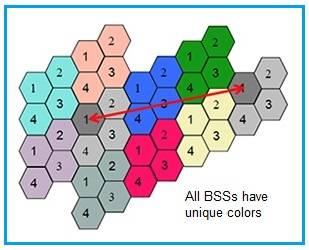BSS Coloring in 802.11ax WLAN: Definition and Benefits
Advertisement
This page describes the BSS Coloring concept used in the WLAN 802.11ax standard. It highlights the benefits and advantages of BSS coloring, showcasing how it addresses issues and problems encountered by legacy 802.11 networks (802.11a/b/g/n/ac).
Introduction
To maximize the quality of experience (QoE) and tackle issues like CCI (Co-Channel Interference) and OBSS (Overlapping Basic Service Set) interference present in older 802.11 networks, IEEE 802.11ax introduced several key concepts:
- OBSS: This refers to the overlap or interference between a BSS to which a Station (STA) is associated and neighboring BSSs to which the STA is not associated. STA, in this context, refers to STATION, or client Wi-Fi devices.
- BSS Color Method: As described below, this differentiates between BSSs operating on the same RF channel.
- OBSS Packet Detection (PD): This is the ability to detect signals originating from other BSSs.
- CCA (Clear Channel Assessment) Threshold Control: This is the ability of a Wi-Fi device to adjust its CCA sensitivity based on its associated Access Point (AP) and the current transmission environment.
An Access Point (AP) along with its associated client devices are collectively known as a BSS (Basic Service Set).

Figure 1: WLAN 802.11 OBSS Issue
Figure 1 illustrates a low frequency reuse scenario using 20 MHz channels. In this case, co-channel interference is typically not an issue. However, the same figure also depicts a high frequency reuse scenario utilizing 80 MHz channels. In this case, all same frequency channels used by BSSs in the Wi-Fi network are blocked. In such dense Wi-Fi deployments, neighboring APs can cause co-channel interference. Stations located in overlapping areas will experience excessive backoff, resulting in performance degradation. This situation is the OBSS (Overlapping Basic Service Set) interference or CCI (Co-Channel Interference) problem.
What is BSS Coloring?

Figure 2: 802.11ax BSS coloring
The issues present in legacy 802.11 networks are mitigated by the BSS coloring concept introduced in the IEEE 802.11ax standard. With BSS coloring, stations can identify transmissions from different networks and react accordingly. Figure 2 illustrates the BSS coloring concept. Here, same-channel BSSs are only blocked if their colors match.
In BSS coloring, each BSS (i.e., AP) uses a unique “color,” a 6-bit identifier carried in the signal preamble or SIG field of the transmitted frame. Each STA (i.e., client) learns its BSS color upon association with its AP, as well as the colors of other BSSs (OBSSs) in the vicinity.
Benefits or Advantages of BSS Coloring
-
It’s a technique used to improve the co-existence of overlapping BSSs (OBSS) and enable spatial reuse within the same channel.
-
Signals with the same BSS color use a low RSSI (Received Signal Strength Indicator) threshold for deferral. This reduces collisions within the same BSS. Essentially, BSS coloring helps mitigate the Co-Channel Interference (CCI) problem found in older Wi-Fi networks.
-
Signals with different BSS colors use a higher RSSI threshold for deferral. This facilitates more simultaneous transmissions.
Advertisement
 RF
RF


